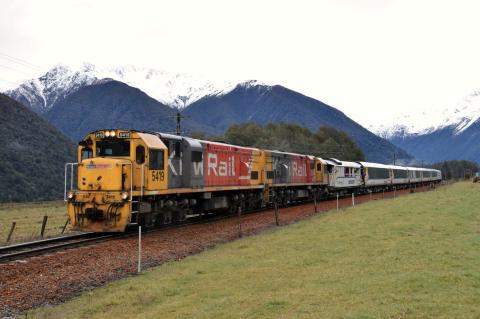NB: The below is a brief plain English summary of key points in the Report issued today by the Transport Accident Investigation Commission. The report speaks for itself.
TAIC report on parting of passenger train exposes gaps in inspection and response:
- All sectors: properly inspect safety-critical components
- Train crews/employers: practice plans for swift, safe response to mechanical failures.
What happened
The TranzAlpine passenger train parted at low speed en route from Greymouth to Christchurch
- It had four locomotives at the front hauling six passenger carriages and two more locomotives at the tail end.
- During descent to Arthur’s Pass station, all carriages and the tail locomotive were braking hard while the four locomotives at the front were still driving forward.
- While moving at about 3 km/h, the first and second carriages parted when a coupler tailpin snapped, triggering the emergency brakes.
After discovering the parting, the crew changed the train configuration. Two of the original four front locomotives took carriage 1 to Christchurch. The other two front locomotives reconnected to the front of carriage 2 and the rest of the train with the passengers and returned to Christchurch, departing Arthurs Pass about an hour late.
Why it happened
Inside the coupler that joined carriage 1 to carriage 2, a single component– a tail pin – snapped because it had a pre-existing and undetected fracture and it was under tensile stress while the train was ‘power braking’ on its downhill run.
Power braking is a driving technique to control a long, heavy train heading downhill by applying the train’s brakes while the locomotives keep pulling forward; it stretches out the train and avoids bunching and rough movement. Overdoing it can cause partings, and using it is against KiwiRail’s guidelines for locomotive engineers.
Safety Issues
1. Inadequate inspection of carriage coupler components
KiwiRail’s maintenance inspections should have detected the fault but they didn’t. A cracked eye bolt went undetected in maintenance checks, leading to the failure.
- TAIC is calling for improvements to inspection and maintenance of safety-critical coupler components. KiwiRail’s work to address this includes new eye bolts (same design) on affected carriages; designing stronger bolts for new couplers (due mid-2025); and weighing up a full redesign of the couplers.
2. Train parting alarm worked but didn’t alert the crew
The train had a Train Management System alarm to alert crew to partings. It’s very likely the TMS alarm worked as designed but the crew didn’t note it. Alarms should be alarming and discernible from one type of alarm to another, making it obvious what to be alarmed about.
- TAIC wants KiwiRail to improve TMS so it reliably alerts crew to faults like train parting. KiwiRail is planning to adjust alarm volume and duration.
3. No procedures to respond to a mechanical train parting
Crew had no documented process to manage their response to the parting.
- TAIC is calling for KiwiRail’s Operational Rules to include parting response procedures.

